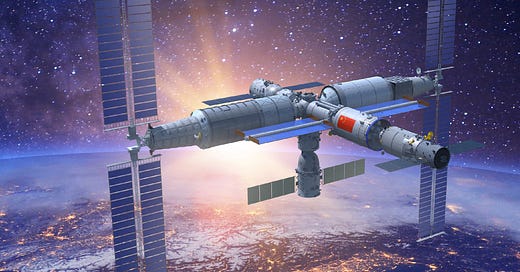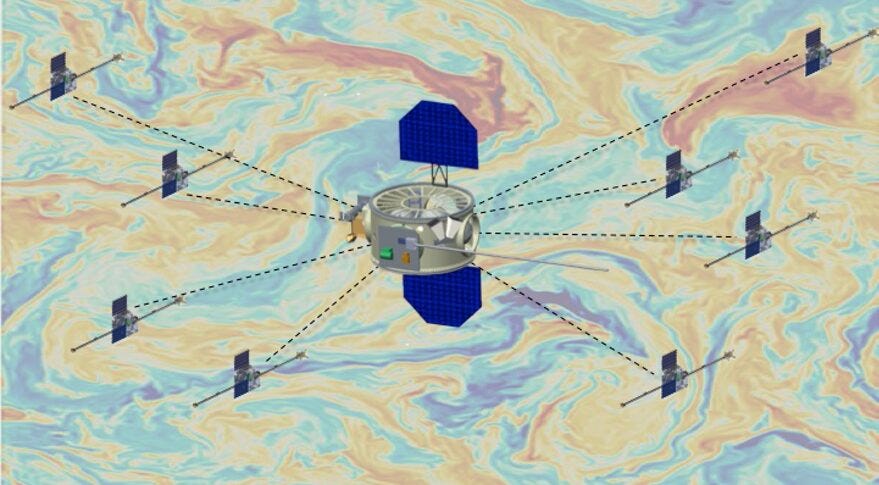The Space Roundup - Feb 13th, 2022
Hello, hello, my dear space lover!
Are you ready for yet another week of space awesomeness? 3, 2, 1, zero! Lift-off!
Quick note: if you haven’t subscribed yet, don’t miss an issue by subscribing below to receive your weekly dose of space awesomeness:
Ah! And if you want to sponsor this newsletter, drop me an email.
SpaceX updates
What a week for SpaceX! They didn’t start the month of February with the best luck: dozens of Starlink satellites re-entered the atmosphere on fire after a geomagnetic storm.
But on Thursday they finished assembling Starship, the world’s largest rocket, with a pair of giant robot arms: how amazing is that?! During the long-awaited Musk’s presentation, he shared a lot of progress has been made on Raptor 2 engines (more power, fewer parts) which is the current bottleneck on the rocket production line.
Here you can see a time-lapse video of the rocket stacking: so impressive!
After all the problems they are currently experiencing to get the permission to launch the first Starship from Boca Chica, SpaceX is now considering shifting Starship testing to Florida although that might mean more delays for the first orbital launch that is supposed to happen this year. We’ll see. Go, SpaceX!
Sats everywhere
The loss of Starlinks wasn’t the only bad news last week for SpaceX. NASA outlined a series of concerns about Starlink's next-generation constellation in an FCC letter. They are very worried that the sats constellations might pose serious risks for space missions and might be a source of growing space debris.
Talking about space debris, the Space Force shared that it is eager to invest in debris removal projects. Nice! Point for the SF! :)
Another piece of bad news came from Astra. Astra launched a series CubeSats for NASA…but it failed three minutes after lift-off. Very sad. I hope they learn from the mistakes and keep improving for the next mission. Rocket science! This is hard! Go, Astra!
Martian updates
NASA has awarded a contract to Lockheed Martin to develop the rocket that will retrieve the first samples from mars to bring them back to Earth. This is one of the most difficult space missions ever attempted and it will be the first autonomous rocket lift-off on another planet. Soooooo cool and inspiring!
How easy is it to create oxygen from water on the Moon and Mars? Harder than on Earth, a study finds. A team of researchers found out that gravity has an impact on our ability to produce oxygen from the water we might collect from the Moon and Mars. Hopefully, this serves to keep improving ISRU equipment currently in development.
Talking about Mars, would it be smart to emulate bears on our trips to Mars and hibernate to reduce consumption of food, oxygen and reduce stress and conflicts? This is what ESA has been studying and it seems it is less science-fiction and more science than we might think.
China
Last week Tianwen 1, the Chinese Mars probe, sent a selfie video to celebrate the Winter Games.
And this week, China released a document with all the projects planned for the year. The most amazing mission is a set of launches to keep growing their Space Station module after module, to a total of 6 spacecraft, and sending several crews to live up there and perform scientific experiments. This is going to be a huge year for China
Astronomy
New exoplanet! Yay! Our Sun’s nearest neighbor, Proxima Centauri, has another planet orbiting. We already knew it had Proxima Centauri-b and Proxima Centauri-c…and now a new planet called Proxima Centauri-d has been discovered. Given how close these planets are to us, the opportunity to learn a lot about them is so promising! Nice
NASA telescope spots the highest-energy light ever detected from Jupiter. Auroras? Yes! Jupiter has amazing auroras. You can learn more about them in this article.
NASA keeps pushing missions to learn more about the Sun. It is definitely a matter of interest for how it impacts our everyday lives and the importance it has for humanity.
That is why it has announced two new missions to keep exploring our star: MUSE and HelioSwarm.
This last mission, HelioSwarm, is especially impressive, as it consists of a swarm of nine spacecraft sent together to “capture the first multiscale in-space measurements of fluctuations in the magnetic field and motions of solar wind”. Impressive!
Launches of the week
The following launches are scheduled for this week:
Mon, Feb. 14th - ISRO EOS-04 (RISAT-1A) | PSLV
Mon, Feb. 14th - Rocket Lab Electron • BlackSky 16 & 17
Tue, Feb. 15th - ROSCOSMOS Soyuz 2.1a | Progress MS-19 (80P)
Sat, Feb. 19th - Northrop Grumman Antares 230+ | Cygnus CRS-2 NG-17
And that’s it for this week!
If you like the Space Roundup please share it with others and if you want to support the project, please go to Patreon to see available subscription options starting from as little as $3/month.
Cheers from sunny Spain!
Juan, the Curious Astronaut






